
|   |

|   |
Bhagirath Nritya Utsav -Nita Vidyarthi e-mail: nitavidyarthi@gmail.com February 13, 2018 Narteswar Cultural Centre welcomed the New Year with their annual Bhagirath Nritya Utsav at Bhasa Mukta Mancha, the open-air stage situated amidst the sprawling Deshapriya Park, Kolkata. The relatively young two-day classical dance festival spearheaded by Dr. Pushpita Mukherjee, accommodates upcoming dancers and groups of renowned gurus side by side with a couple of solo performances by seasoned artists. Acclaimed dance gurus are honoured every year with the ‘Biral Prativa Award’ (rare talent award) which includes a citation and a purse. This year it went to Odissi Guru Durgacharan Ranbir. Odissi dance gurus Sutapa Talukdar, Gajendra Panda, Aloka Kanungo, Uday Shankar Professor and Kathak exponent Amita Dutta, and others from the field of academics and ISKCON were felicitated in the ‘Shraddharpan’ segment prior to the performances on the inaugural evening and Kalavati Devi (Manipuri), Kathakali and Bharatanatyam exponent Kalamandalam Shankar Narayan and Professor P.R. Bhattacharya on the second. 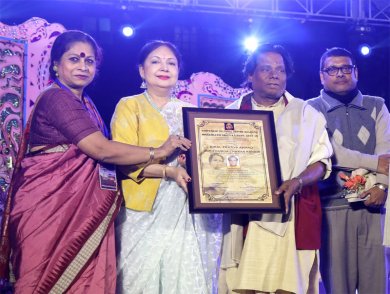
Guru Durgacharan Ranbir gets Biral Prativa Award
The first evening was exclusive to 13 Odissi performances and the second went to a mixed bag of 11 from other classical forms. Dancers of Narteswar Cultural Centre opened the festival with the ashtapadi “Sritakamala kucha mandala” directed by Prof. Pushpita Mukherjee. The dancers tried, but are yet to mature in order to capture the nuances of this ecstatic Jayadeva masterpiece. While some of the dancers were striving to grasp the art, others did prove their mettle with their training and effort, alongside the seasoned dancers and seniors, groomed by their acclaimed gurus. Dancers mostly concentrated on nritta, Pallavi being a popular choice. 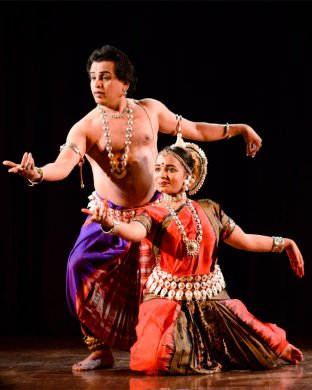 Guru Gajendra Panda & MokshadaTripathy The only senior guru performing in the festival was Odissi Guru Gajendra Panda, torch bearer of the Guru Debaprasad gharana, together with his disciple MokshadaTripathy in a duet rendition of “Ardhanareeswar”, choreographed by Gajendra Panda, woven with the music of Balkrushna Das and Lakshmikant Palit with the exotic rhythm of Guru Dhaneswar Swain. The piece set to raga Malabakaushiki in tala triputa and ektali saw a very mature and technically competent promising dancer in Mokshada whose sparkling eye movements, energy and attention to details both in nritta and abhinaya matched her guru’s verve and communicative strength of the Adi Shankaracharya composition. The piece embellished with the signature Shabdaswara Patha of Debaprasad Das has been presented as a solo by the guru and also as a duet a number of times, but this one with Mokshada as the female counterpart was certainly special. While Gajendra Panda pivoted the performance with his tandava distinction, Mokshada displayed the lasya elements with grace and confidence of a fine dancer. That Mokshada is a highly professional dancer in the making was proved by the fact that she steered through the performance smoothly without letting the spectators realise at any point of a bleeding cut by a nail prick on stage while dancing! 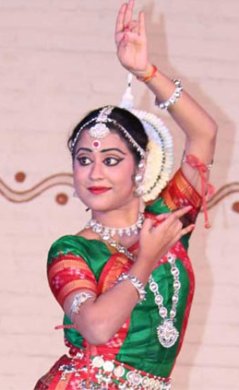 Sriradha Paul Gratifying solo presentations by three young disciples of Guru Aloka Kanungo stood out for their training proving Kanungo’s dedication and effort to train these young girls into competent dancers. Twelve year old Debeshree Sen’s Aaravi Pallavi in ektali showed the confidence of a skilled dancer, negotiating the intricacies of the rhythm of this pure dance number with ease. Urjjasee Basak handled “Mahavidya” with strength and grace and Ashmita Mohanty showed spark in handling the “Shankarabharanam” Pallavi. Both these sixteen year-olds have a long way to go and with their dedication and guidance of their caring guru, they would certainly emerge as brilliant dancers in future. 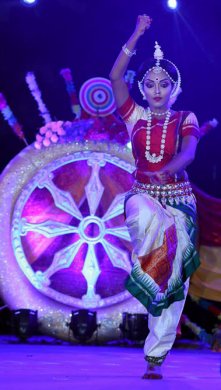 Santasree Sasmal Another delightful dancer trained by Guru Bichitrananda Swain was Sriradha Paul. She lived up to her training in the “Mahakali Stuti” set to raga Malkauns, ektali by Binod Bihari Panda. Clarity of movements, sharp hastas and stretched limbs transformed each word of the lyrics into powerful gestures and expressions. With lyrical grace, Santasree Sasmal gave a good account of herself in the piece “Dhyaye Subarna Varna” choreographed by Guru Gangadhar Pradhan. The dance was directed by Rojalin Mohapatra. Among the male dancers, Kakoli Bose’s student Sanjoy Bhattacharya did not rise above mediocrity. Pushpita Mukherjee’s students Jeet Ghosh and Priyanka Banerjee presented an impressive duet. 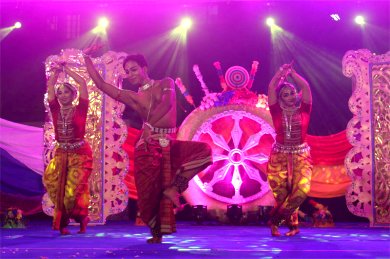 Disciples of Guru Sutapa Talukdar Trained by the acclaimed Guru Sutapa Talukdar, the dancers of her troupe stood out among the three group presentations. Beginning with the traditional “Mangalacharan” followed by Pushpanjali and the Trikhandi Pranam (three-fold salutation), the group presented “Gourinandana,” a sophisticated choreographic tribute to Lord Ganesha set to raga Mohana, ektali with lyrics by Nabakishore Misra, music and vocal support by Sukanta Kundu and pakhawaj by Ramchandra Behera. Aptly choreographed with two female and a male dancer depicting the movements of Ganesha with his elephant trunk and sharp tusks used as weapons for enemies, he is Senapati of the “Vinayak ganas”- the armed, dark, frightening warriors born out of the fierce anger of Rudra. Sourav Samanta, the only male dancer in this group, evinced stamina and shrewd neatness with able support by Procheta Roy and Oishanee Bhattacharjee. Arratali Pallavi in raga Kamodi was a real treat. Negotiating this not so common time cycle, the female dancers moved with razor sharp control over rhythm, fine finishing and strong footwork with the lyrics of Nabakishore Misra set to music by Sukanta Kundu and the percussive patterns of Ramachandra Behera’s pakhawaj support. The choreography by Sutapa Talukdar was imaginative with some well coordinated floor movements seldom seen in a Pallavi. The white, blue and red bordered traditional costumes needs special mention and so does the stage understanding and spacing that comes from rigorous training. “Durga Tandav” by members of Kala Vikas Kendra, Cuttack, was another creatively presented piece set to raga Patdeep, tala triputa, choreographed by Gajendra Panda with Lakshmikant Palit’s music and Dhaneswar Swain’s rhythm. Beginning with “Dhyan” where Goddess Durga stands majestically on the lion holding veena, pustaka, khadga and shula on the right hand and ghanta, karmukh (dhanush) and demon’s head on the left, the choreography moves on to Mahishasur Badh (slaying the demon Mahishasur) and then Durga Tandav. Noteworthy feature of this presentation was good teamwork and good formations. The evening concluded with a group performance by Malashree directed by Arpita Venkatesh. The performances by students of seasoned teachers slated for the second evening are not discussed here due to the inability of the reviewer to attend it. Responding to the aesthetics of this festival which is definitely an attempt to popularise and preserve the classical dances of India, at the same time offering young, upcoming dancers to present their fare and learn to evaluate their training from the performance of renowned dancers and gurus, it is important to pay attention to the aesthetics of the art. The random placing of the monitors on the concrete stage restricted the movements and spontaneity of the dancers who perhaps were incapable of giving their best. The spectators strived to find a comfortable angle to watch the performances. Cumbersome props with glittering coloured tinsels cluttered on stage, acting as backdrops, reduced the performance space. The chaotic light projections and abundance of smoke pumped on stage during performances not only fogged the stage but hampered the pleasure of enjoying the details of the dancers’ hand gestures and expressions. And then there were the evening walkers moving past in front of the stage, sometimes stopping to get a glimpse of what is going on! Should the gurus and teachers start educating their students on the management of these drawbacks that dilute their performances? Proper planning would do justice both to the dancers and the spectators for enjoying the performances at their best. Dr. Nita Vidyarthi is a veteran critic of performing arts and writes on dance, music and theatre in leading publications. |